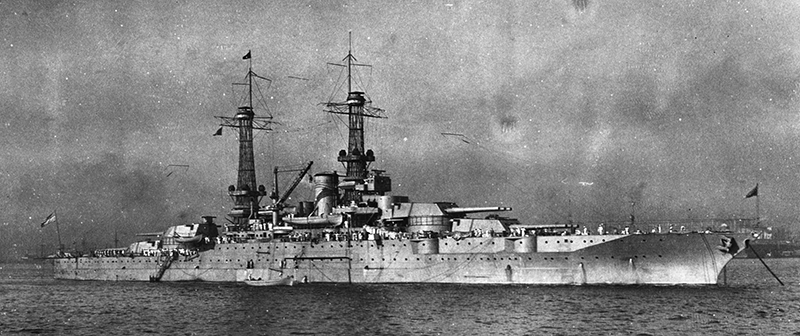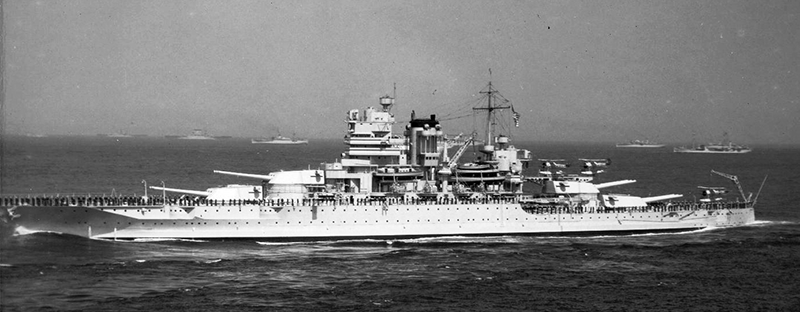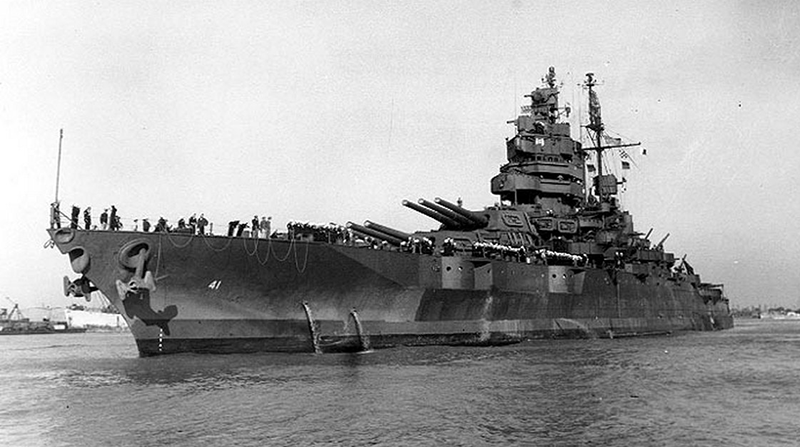
NAVYPEDIA
 Support the project with paypal
Support the project with paypal
Photo
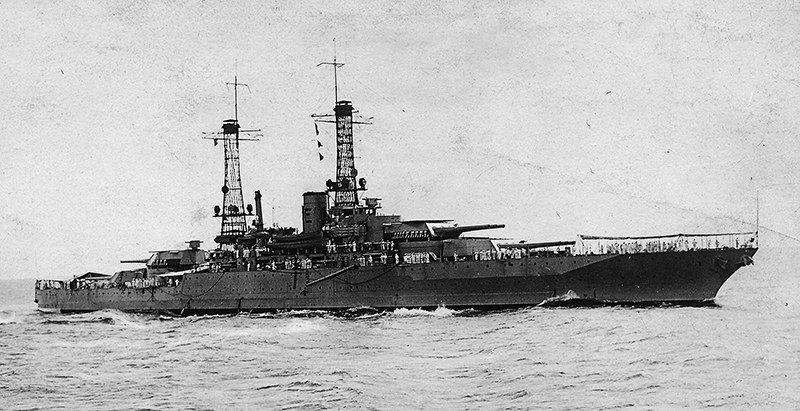
Idaho in mid 1920s
Ships
| No | Name | Yard No | Builder | Laid down | Launched | Comm | Fate |
|---|---|---|---|---|---|---|---|
| BB40 | New Mexico | New York N Yd, Brooklyn | 14.10.1915 | 23.4.1917 | 20.5.1918 | stricken 2.1947 | |
| BB41 | Mississippi | 185 | Newport News | 5.4.1915 | 25.1.1917 | 18.12.1917 | gunnery test ship AG128 2.1946, stricken 7.1956 |
| BB42 | Idaho | 160 | New York SB, Camden | 20.1.1915 | 30.6.1917 | 24.3.1919 | stricken 11.1947 |
Technical data
| Data variant | as commissioned | 1932-1933 modernization |
|---|---|---|
| Displacement standard, t | --- | 33420 |
| Displacement normal, t | 32000 |
|
| Displacement full, t | 33000 |
36157 |
| Length, m | 182.9 wl 190.2 oa |
182.9 wl 190.2 oa |
| Breadth, m | 29.7 |
32.4 |
| Draught, m | 9.10 |
9.44 full load |
| No of shafts | 4 |
4 |
| Machinery | BB40: 4 electric motors, 2 General Electric (Curtis) turbo-generators, 9 Babcock & Wilcox boilers BB41: 4 Curtis steam turbines, 9 Babcock & Wilcox boilers BB42: 4 Parsons steam turbines, 9 Babcock & Wilcox boilers |
BB40: 4 sets Westinghouse geared steam turbines, 4 White Forster boilers BB41, 42: 4 sets Westinghouse geared steam turbines, 6 Bureau Express boilers |
| Power, h. p. | BB40: 27500 BB41, 42: 32000 |
40000 |
| Max speed, kts | 21 |
22 |
| Fuel, t | oil 3270 |
oil 5402 (max 7053) |
| Endurance, nm(kts) | BB40: 5120(12) BB41: 7020(12) |
22000(10) - 26000(10) |
| Armour, mm | belt: 343 - 203, bulkheads: 343 - 203, deck: 89, 63 over steering gear, barbettes: 320, turrets: 457 face, 254 - 229 sides, 229 rear, 127 crowns, CT: 406 sides, 127 roof |
belt: 343 - 203, bulkheads: 343 - 203, deck: 140, splinter deck: 70, barbettes: 32, turrets: 457 face, 229 sides, 127 rear, 127 crowns, CT: 406 sides, 127 roof |
| Armament | BB40, 42: 4 x 3 - 356/50 Mk IV, 14 x 1 - 127/51 Mk VIII, 4 x 1 - 76/52 Mk X, 2 - 533 TT (beam) BB41: 4 x 3 - 356/50 Mk IV, 22 x 1 - 127/51 Mk VIII, 4 x 1 - 76/52 Mk X, 2 - 533 TT (beam) |
4 x 3 - 356/50 Mk 7.11, 12 x 1 - 127/51 Mk 8, 8 x 1 - 127/25 Mk 10.11.13, 2 catapults, 3 seaplanes (O2U, O3U) |
| Complement | 1084 |
1443 |
Standard scale images
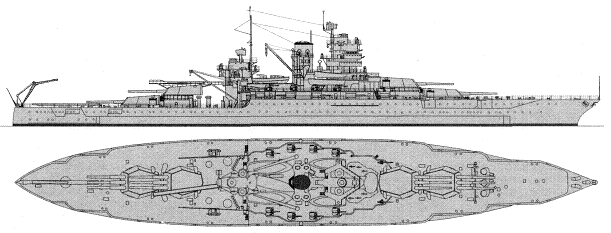
New Mexico 1940

Mississippi 1945
Graphics
Project history
In 1913-14 the General Board called for an entirely new battleship design, displacing about 35500 tons, and armed with 10 406mm guns in five twin turrets. Josephus Daniels, the Secretary of the Navy, refused to countenance any substantial increase in tonnage, and decided that the FY 14 battleships would essentially duplicate the Pennsylvanias, with whatever improvement that could be incorporated at minimum cost. Two were involved.
First, there was the old complaint of wetness. These ships had a clipper bow, and 12 of their 22 127mm/51 guns were mounted in a deckhouse, one deck level above the secondaries of the previous class. They still retained 4 guns in the forecastle deck forward, and 4 more right aft, below the main deck; another pair was in the open mounts atop the deckhouse. One of the three ships was actually completed with all 22 guns, but by that time American experience in the North Sea was showing that only the deckhouse guns would be usable in a seaway. The bow and after positions were soon plated in, reducing the number to 14.
The other major improvement was in main battery gunnery: these ships introduced a new 356mm/50 gun, and the weapons elevated independently, in contrast with earlier classes.
A series of detail weight economies permitted the designers to thicken the armoured bulkheads from 330mm to 343mm, and the main armour deck from 76mm to 89mm, both of which figures became standard for later US dreadnoughts.
One ship, the New Mexico, tested the turbo-electric drive system advocated by General Electric as an alternative to gearing, The collier Jupiter, which became the aircraft carrier Langley, had already served as a test platform. The Bureau of Steam Engineering wanted turbo-electric drive for economy, and to do away with astern turbines, which were giving trouble. C&R saw the new system as a means to improve subdivision, and employed it in all of its later dreadnoughts and battlecruisers. It was abandoned after World War One only because of its excessive demands on weight and internal volume.
Two ships were originally planned, but proceeds of the 1914 sale to Greece of the pre-dreadnoughts Mississippi and Idaho paid for a third ship. As result, 1915 programme included three battleships of this class.
Ship protection
125m belt had 5.2m height and was 343mm thick at upper part tapering to 203mm at lower edge. Belt was connected with end barbettes by 343mm bulkheads. There was 2.6m in height 203mm belt at 18.3m length aft from aft bulkhead, protecting steering gear, it was closed aft by 343mm bulkhead. Flat main armour deck was connected with upper edge of belt and was 89mm over citadel. One level lower there was 38mm splinter deck with 51mm slopes, slopes were connected with lower edge of belt. This deck was 63mm thick aft from citadel, protecting steering gear. Main gun turrets had 457mm faces, 254-229mm sides, 229mm rears and 127mm crowns. Barbettes were 320mm over and 114mm under main deck. CT had 406mm sides and 127mm roof. Underwater protection was 5.4m deep. There was 76mm longitudinal bulkhead.
Ship protection after modernization: 125m belt had 5.2m height and was 343mm thick at upper part tapering to 203mm at lower edge. Belt was connected with end barbettes by 343mm bulkheads. There was 2.6m in height 203mm belt at 18.3m length aft from aft bulkhead, protecting steering gear, it was closed aft by 343mm bulkhead. Flat main armour deck was connected with upper edge of belt and was 140mm over citadel. One level lower there was 70mm splinter deck with 51mm slopes, slopes were connected with lower edge of belt. This deck was 63mm thick aft from citadel, protecting steering gear. Main gun turrets had 457mm faces, 254-229mm sides, 229mm rears and 127mm crowns. Barbettes were 320mm over and 114mm under main deck. CT had 406mm sides and 127mm roof. Underwater protection was 6.7m deep. There was 76mm longitudinal bulkhead.
Modernizations
1922, all: - 2 x 1 - 127/51; + 4 x 1 - 76/52 Mk X
1924 - 1925, New Mexico, Idaho: + 1 catapult, 1 seaplane (MO, UO, VE or OL)
1924 - 1925, Mississippi: + 2 catapults, 3 seaplanes (MO, UO, VE or OL)
(3/1931 - 1.1933, Philadelphia NYd) New Mexico, (3/1931 - 8.1932, Norfolk NYd) Mississippi, (9/1931 - 10.1934, Norfolk NYd) Idaho: were modernized as follows. New machinery and boilers were fitted, horizontal armour was strengthened. Maximal main guns elevation angle was increased up to 30°.
mid-1941, all: - 2 x 1 - 127/51; + 4 x 1 - 76/50 Mk 20, (8 - 10) x 1 - 12.7/90
12/1941 - 1.1942, all: - 4 x 1 - 76/50, (4 - 6) x 1 - 12.7/90; + 4 x 4 - 28/75 Mk 1, 8 x 1 - 20/70 Mk 4, SC, Mk 3 radars
11/1942, New Mexico, Mississippi: - 4 x 1 - 127/51, 4 x 1 - 12.7/90, 1 catapult; + 2 x 4 - 40/56 Mk 1.2, 6 x 1 - 20/70 Mk 4, SG radar
12/1942, Idaho: - 10 x 1 - 127/51, 4 x 4 - 28/75, 4 x 1 - 12.7/90, 1 catapult; + 10 x 4 - 40/56 Mk 1.2, 16 x 1 - 20/70 Mk 4
2/1943, Idaho: + 19 x 1 - 20/70 Mk 4
10/1943, New Mexico: - 4 x 4 - 28/75, SC radar; + 2 x 4 - 40/56 Mk 1.2, 2 x 2 - 40/56 Mk 1.2, 10 x 1 - 20/70 Mk 4, Mk 3 (2nd), SG (2nd), SK radars
10/1943, Mississippi: - 4 x 4 - 28/75, SC radar; + 2 x 4 - 40/56 Mk 1.2, 2 x 2 - 40/56 Mk 1.2, 15 x 1 - 20/70 Mk 4, Mk 3 (2nd), SG (2nd), SK radars
1/1944, New Mexico: + 19 x 1 - 20/70 Mk 4
1/1944, Mississippi: + 21 x 1 - 20/70 Mk 4
late 1944, New Mexico, Mississippi: - Mk 3 radar; + 6 x 4 - 40/56 Mk 1.2, Mk 8, Mk 27, 2x Mk 28 radars
1/1945, Idaho: - 8 x 1 - 127/25, Mk 3 radar; + 10 x 1 - 127/38 Mk 12, Mk 8, Mk 27, 2x Mk 28 radars
4/1945, Mississippi: CT was replaced by lighter one with 38mm armour; - 6 x 1 - 127/51, 10 x 1 - 20/70; + 8 x 1 - 127/25 Mk 10.11.13, 2 x 4 - 40/56 Mk 1.2
mid-1945, Mississippi: - 6 x 1 - 20/70; + 1 x 4 - 40/56 Mk 1.2
1/1946, BB40 New Mexico: 4 x 3 - 356/50 Mk 7.11, 6 x 1 - 127/51 Mk 13, 8 x 1 - 127/25 Mk 19, 10 x 4 - 40/60 Mk 2, 2 x 2 - 40/60 Mk 1, 43 x 1 - 20/70 Mk 10, 1 catapult, 3 seaplanes, 2x SG, SK, Mk 3, Mk 8, Mk 27, 2x Mk 28 radars
1/1946, BB41 Mississippi: 4 x 3 - 356/50 Mk 7.11, 16 x 1 - 127/25 Mk 19, 13 x 4 - 40/60 Mk 2, 2 x 2 - 40/60 Mk 1, 34 x 1 - 20/70 Mk 10, 1 catapult, 3 seaplanes, 2x SG, SK, Mk 3, Mk 8, Mk 27, 2x Mk 28 radars
1/1946, BB42 Idaho: 4 x 3 - 356/50 Mk 7.11, 10 x 1 - 127/38 Mk 24, 10 x 4 - 40/60 Mk 2, 43 x 1 - 20/70 Mk 10, 1 catapult, 3 seaplanes, SC, Mk 8, Mk 27, 2x Mk 28 radars
4/1948, Mississippi: was armed with 1 x 3 - 356/50 Mk 7.11, 2 x 1 - 127/54 Mk 39, 3 x 2 - 127/38 Mk 32, 2 x 2 - 76/50 Mk 33, 2 x 4 - 40/60 Mk 2, SX, Mk 29, 2x Mk 25, 3x Mk 35, Mk 28, 5x Mk 29, 3x Mk 47, 3x SPG-50 radars
4/1948, Mississippi: + 1 x 2 - 152/47 RF Mk 16
1952, Mississippi: - 1 x 3 - 356/50, 2 x 4 - 40/60; + 2 x 2 Terrier SAM
Naval service
New Mexico 6.1.1945 was damaged by kamikaze and was under repair till March, 1945; 12.5.1945 she was again badly damaged by kamikaze and gone to repair till August, 1945. Mississippi 9.1.1945 was damaged by kamikaze and was repaired in March-April, 1945; 5.6.1945 she was again damaged by kamikaze and was under repair for one month.
1940 (Navypedia)
 HOME
HOME FIGHTING SHIPS OF THE WORLD
FIGHTING SHIPS OF THE WORLD UNITED STATES OF AMERICA
UNITED STATES OF AMERICA CAPITAL SHIPS AND MONITORS
CAPITAL SHIPS AND MONITORS NEW MEXICO battleships (1917 - 1919)
NEW MEXICO battleships (1917 - 1919)
